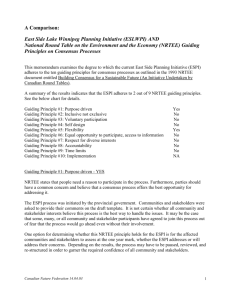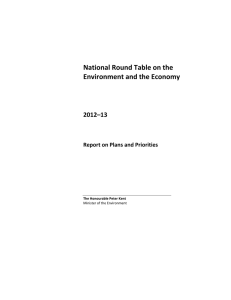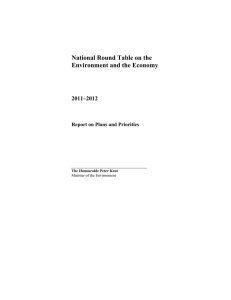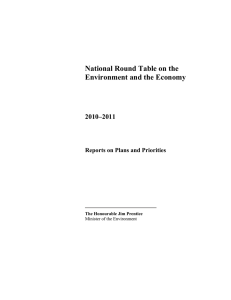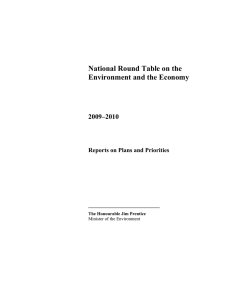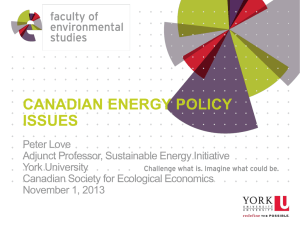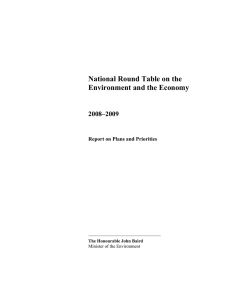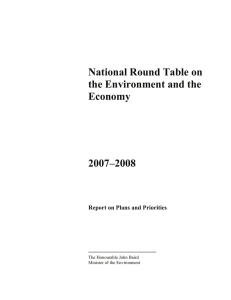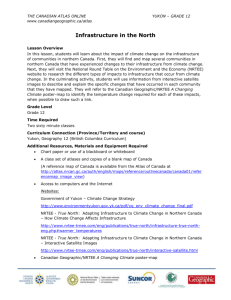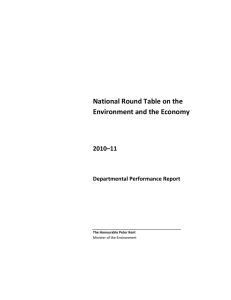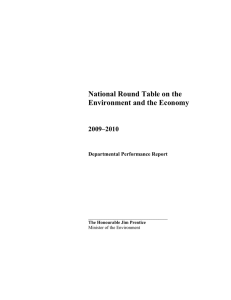National Round Table on the Environment and the Economy
advertisement
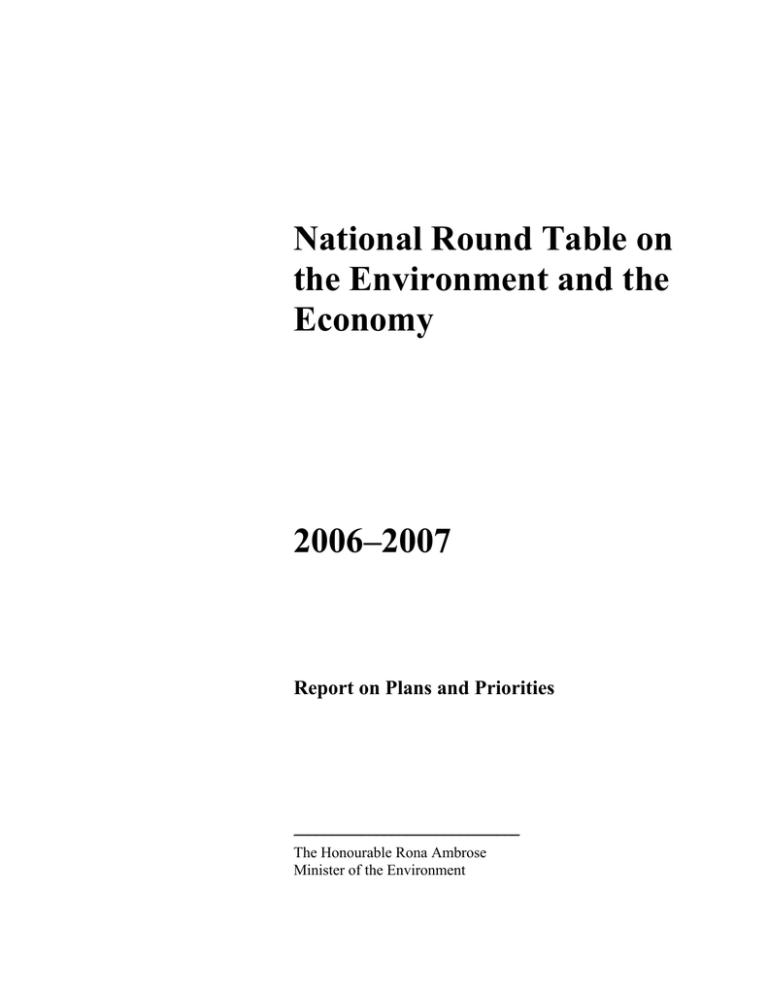
National Round Table on the Environment and the Economy 2006–2007 Report on Plans and Priorities ______________________________ The Honourable Rona Ambrose Minister of the Environment Table of Contents SECTION I: OVERVIEW ........................................................................................................1 Message from the Chair and the President ..............................................................1 Management Representation Statement...................................................................3 NRTEE Program Activity Architecture...................................................................4 Summary Information..............................................................................................5 Departmental Plans and Priorities............................................................................7 SECTION II: ANALYSIS OF PROGRAM ACTIVITIES BY STRATEGIC OUTCOME .................13 Strategic Outcome..................................................................................................13 Program Activity: Provide advice on environment and economy issues ..............13 Key Program 1: Produce advice through research and stakeholder consultation..13 Key Program 2: Promote NRTEE advice ..............................................................15 SECTION III: SUPPLEMENTARY INFORMATION .................................................................17 Organizational Information and Organization Chart .............................................17 Table 1: Departmental Planned Spending and Full-Time Equivalents..................18 Table 2: Program Activities ...................................................................................19 Table 3: Voted and Statutory Items Listed in Main Estimates ..............................20 Table 4: Services Received Without Charge .........................................................21 Table 5: Summary of Capital Spending by Program Activity...............................22 Table 6: Sources of Respendable and Non-Respendable Revenue .......................23 Table 7: Internal Audits and Evaluations...............................................................24 SECTION IV: OTHER ITEMS OF INTEREST .........................................................................25 Contact for more information ................................................................................25 NRTEE Members...................................................................................................25 SECTION I—OVERVIEW 1.1 Message from the Chair and the President The National Round Table on the Environment and the Economy (NRTEE) is dedicated to exploring new opportunities to integrate environmental conservation and economic development in order to sustain Canada’s prosperity and secure its future. Drawing on the wealth of insight and experience represented by our diverse membership, we examine the environmental and economic implications of priority issues, and offer independent advice on how best to address the challenges and seize the opportunities that emerge from them. Our activities are directly relevant to Canada’s national interest and to the government’s objective of building a globally competitive, sustainable, technologically innovative economy. Created by the Prime Minister in 1988 as an independent advisory body reporting to the federal government, the status of the NRTEE was formalized in a 1993 Act of Parliament . We report to the federal Minister of the Environment, but, as a national body, we share our advice with other levels of government and decision makers in various sectors. Our members come from different regions of Canada. They are distinguished leaders in business and labour, universities, environmental organizations, Aboriginal communities and municipalities. The NRTEE facilitates the exchange of ideas by offering our members and other stakeholders a neutral forum for discussion. The NRTEE also acts as an advocate for positive change, raising awareness about the challenges of sustainable development and promoting viable solutions for addressing them. Over the past 12 years, the NRTEE has nurtured a depth and breadth of expertise, integrating the views of stakeholders across the country in many key sectors, establishing a reputation for working effectively in highly contentious areas, and providing credible, balanced advice that decision makers in government and industry can trust. In 2005, the NRTEE adjusted to working with a new chair and several new members. The transition and period of adjustment will continue into 2006–2007, when a new President and CEO will be appointed, and as we adapt to working in a different policy environment as a result of a change in government and a new reporting relationship with the Minister of the Environment. In 2005–2006, we focused on providing advice to the Government of Canada on long-term issues relating to energy and climate change. As a result of these efforts, the NRTEE has developed expertise that positions us well to provide a unique and substantial contribution to Canada’s performance. In 2006–2007, we plan to capitalize on this expertise by strengthening our internal capacity and continuing to focus on these issues. We will be developing specific policy proposals that will suggest how Canada can implement the low-carbon strategic priorities identified in our earlier work. We will also undertake a major communications initiative to raise awareness and solicit feedback on our 2005-2006 findings and proposed advice. The target audience for this exercise will include all levels of government as well as community, business and civic leaders. -1- In parallel, we will be laying the foundation for activities beyond 2006–2007. Consistent with our mandate, we will initiate an ongoing strategic review of issues that are relevant to the national interest. This will enable us to anticipate the needs of decision makers and respond effectively with valuable policy recommendations and advice. In addition, we will maintain an active role in the examination and promotion of economic instruments as a tool for advancing sustainable economic growth—an area in which we have proven capability. As part of our commitment to strengthen our management approaches and accountability, we will continue to participate in selected government-wide management objectives, including Management of Government Information, the Government Content Management Solution, and Management Accountability Framework (MAF) Assessments. We are committed to maintaining a focus on our mandate and to helping the federal government face the sustainable development challenge head-on in 2006 and beyond. We look forward to playing a part in the promotion of economic prosperity and in the preservation of the environment for future generations. ________________________ Glen Murray Chair ________________________ Alexander Wood Acting President and Chief Executive Officer -2- 1.2 Management Representation Statement I submit for tabling in Parliament the 2006–2007 Report on Plans and Priorities (RPP) for the National Round Table on the Environment and the Economy (NRTEE). This document has been prepared based on the reporting principles contained in Guide for the Preparation of Part III of the 2006–2007 Estimates: Reports on Plans and Priorities and Departmental Performance Reports. It adheres to the specific reporting requirements outlined in the TBS guidance: • It is based on the department’s approved Program Activity Architecture structure as reflected in its MRRS; • It presents consistent, comprehensive, balanced and accurate information; • It provides a basis of accountability for the results achieved with the resources and authorities entrusted to the NRTEE; and • It reports finances based on approved planned spending numbers from the Treasury Board Secretariat in the RPP. Alexander Wood Acting President and Chief Executive Officer -3- 1.3 NRTEE Program Activity Architecture The NRTEE is presenting its plans and priorities for 2006–2007 using the Treasury Boardapproved Program Activity Architecture (PAA) shown in Figure 1. Key elements of this PAA are consistent with those that were used in the 2005–2006 RPP (and in the 2004–2005 Departmental Performance Report). For this reason, we are not providing a crosswalk. Figure 1. The NRTEE Program Activity Architecture Program Activity Architecture National Round Table on the Environment and the Economy Strategic Outcome Federal policy development on environment and economy issues, and decisions in other key sectors, are influenced by NRTEE advice on selected issues Program Activity Provide advice on environment and economy issues (Planned spending 2006-07: $5.183m) Subactivities Promote Advice: Advise federal clients Promote to other key sectors Produce Advice: Identify new knowledge Convene and consult stakeholders -4- 1.4 Summary Information Raison d’Être Economic growth and prosperity are of central importance to Canadians. However, economic activity is placing increasing pressures on the health of the Canadian and global environments. There is an ongoing need to confront this challenge by channelling rigorous research, stakeholder views and the resulting new knowledge into policy making. The NRTEE responds to this need by identifying and promoting ways to encourage economic prosperity for all Canadians. At the same time, it strives to preserve the environment for current and future generations. Financial Resources ($ thousands) 2006–2007 2007–2008 2008–2009 $5,183 $5,189 $5,189 2006–2007 2007–2008 2008–2009 24 25 25 Human Resources (FTEs) Departmental Priorities Planned Spending ($ thousands) Type Activities 2006–2007 2007–2008 2008–2009 Strategic Outcome: Federal policy development on environment and economy issues, and decisions in other key sectors, are influenced by NRTEE advice on selected issues. Priority 1: Provide advice on environment and economy issues. Ongoing Produce advice through research and stakeholder consultation, and promote advice to federal clients and other sectors. Expected Result: Federal clients and national stakeholders are aware of and understand the problems, opportunities and practical solutions identified and examined by the NRTEE. -5- $4,933 $4,929 $4,929 Priority 2: Strengthen management accountability and systems, and implement new federal initiatives. Ongoing The NRTEE will enhance its systems for information and records management, continue its efforts relating to Content Management Solutions, initiate a MAF self-assessment, strengthen its procurement and HR policies, and update its approach to evaluating its performance. Expected Result: The NRTEE moves closer to fully implementing these initiatives. -6- $250 $260 $260 1.5 Departmental Plans and Priorities The NRTEE has a single strategic outcome, namely, federal policy development on environment and economy issues, and decisions in other key sectors, are influenced by NRTEE advice on selected issues. All of the agency’s plans, priorities and activities are directed toward its achievement. Operating Environment The NRTEE reports to the Minister of Environment and is supported by a Secretariat in Ottawa. Its members, which include up to 25 distinguished Canadians, represent a broad range of sectors, including business, labour, academia, environmental organizations and Aboriginal peoples, and many regions across the country. (See Section IV for a list of members.) The Secretariat, headed by a President and CEO, provides program management, analysis, communications and administrative services to the NRTEE members. (See Section III for an organization chart.) General information about the NRTEE and its membership is available on the agency’s Web site (www.nrtee-trnee.ca). Issues examined by the NRTEE have historically been identified through an internal screening and scoping process, in which the final decisions reflect current political, environmental or economic priorities, and members’ combined interests. More recently, the NRTEE’s activities have been determined by the need to respond to specific requests from the federal government, often within short timeframes. In 2005–2006 the NRTEE adopted its approach to respond effectively to these requests, which it expects to continue in the future. One change implemented in 2005–2006 was a greater reliance on NRTEE members for their expertise and advice, with less emphasis on task forces and external stakeholder consultations. The NRTEE’s unique ability to provide independent and credible policy recommendations on a range of issues in a changing political environment will be particularly valuable in responding to the interests and concerns of a new government. NRTEE staff possess a range of expertise and the flexibility to respond to current demands for advice. As the NRTEE seeks to increase capacity in key areas such as economic instruments and strategic intelligence on sustainable development, it will require additional financial and human resources in the future. Planning efforts in these areas will include an explicit consideration of existing staff capacity and future requirements. -7- 1.5.1 PRIORITIES Priority 1: To provide advice to decision makers on environment and economy issues of national relevance Description of the priority The first priority of the NRTEE is to provide advice on issues that involve both the environment and the economy. Although it has a small budget of approximately $5 million, the agency nevertheless delivers an increasing amount of advice on issues of national importance—advice that decision makers in and beyond the federal government agree makes a valuable contribution to our knowledge about sustainable development. Providing advice involves producing the advice, then promoting it. Producing the advice entails conducting original research and convening experts to ensure balance and credibility. The research analyzes the environmental and economic facts and trends underlying each issue area. The resulting policy recommendations are reviewed and approved by NRTEE members who represent various stakeholder groups. The culmination of this effort is a report that presents the findings, analysis and recommendations from the research and consultation process. Historically, the process has taken two to three years to complete, resulting in a State of the Debate report.The NRTEE has more recently sought to streamline its research and consultation efforts, with a view to providing advice that is timely and relevant to the government’s ongoing priorities. Taken in combination with the more deliberate State of the Debate process, this new approach gives the NRTEE flexibility in addressing any issue, based on its nature and on the demands of the key audiences we are targeting with the advice. On completion of a program or an activity, the agency begins its second task, promoting its findings through a variety of communications channels, to reach targeted decision makers and opinion leaders across the country. This second step is crucial in raising awareness and understanding, and in influencing policy development and decision making. Together, producing and promoting advice contribute directly to the agency’s strategic outcome, which is to influence policy and decisions related to environment and economy issues. Plans for 2006 to 2009 The NRTEE will continue its current focus on energy and climate change in 2006–2007, building on the expertise and knowledge base it has developed. A summary of proposed plans is provided below. For further details, see Section II. Produce Advice In addition to wrapping up our 2005-2006 work on energy and climate change, the following two new programs have been identified by NRTEE members as priorities for 2006–2007: -8- • • Energy and Climate Change Phase II: We will develop policy proposals to help implement the recommendations made in the NRTEE energy and climate change work completed in spring 2006. Adaptation to Climate Change: We will examine ways for the NRTEE to contribute to the development of a national climate change adaptation policy for Canada. In addition, we will maintain and develop capacity on the use of economic instruments to promote sustainable development, and we will also identify new issues for possible examination in 2007 and beyond. Promote Advice Our priority in 2006–2007 will be to disseminate the recommendations and advice developed as part of the NRTEE’s 2005-2006 work on long-term energy and climate change issues. This will involve a two-part strategy: • • A multi-city outreach initiative Targeted stakeholder briefings with key constituencies including groups in both the private, non-governmental sector and the public sector; We also plan to release the State of the Debate Report on Capital Markets and Sustainability in Canada. and we will use resources to support the dissemination of findings from the completed NRTEE program on Canada’s boreal forests. Performance indicators for this priority (provide advice and promote advice) As laid out in our Program Activity Architecture (PAA), the agency will have succeeded when decision makers report that the NRTEE has given them a new way of viewing issues and has raised their awareness and understanding of the issues. In the past, performance indicators have been monitored through ongoing evaluation efforts, including surveys of participants in NRTEE processes, and interviews with senior government and industry representatives. However, different approaches to measuring our performance will be assessed in 2006–2007 (see Section 1.5.2). Priority 2: To strengthen management accountability and systems, and implement new federal initiatives Description of the priority Even with limited staff and a small budget, the agency takes seriously its responsibility to ensure that the stewardship of its financial and human resources is effective and aligned with government-wide initiatives. To this end, the agency has identified several areas of focus for this planning period. These are discussed below. -9- Plans for 2006 to 2009 • Management of Government Information: In response to this Treasury Board policy, the NRTEE launched a major initiative in March 2003 to develop policies and procedures for a comprehensive records management program for both paper and electronic files. Plans for 2006–2007 include archiving all paper records and moving them from storage to Library and Archives Canada and the Federal Records Centre. This will ensure that the NRTEE’s corporate memory is properly maintained. As required by Treasury Board, we plan to implement a comprehensive departmental Information Management Policy in 2006, which, along with a common File Plan, will ensure all corporate records, regardless of media, are managed according to government requirements and regulations. The NRTEE will also take steps to manage information in accordance with both the Access to Information and Privacy Acts. Starting in 2006-2007, all NRTEE staff will receive basic training in information management. The NRTEE will continue to assess its need for an electronic information management system such as Records, Document and Information Management System (RDIMS), and we will take steps to comply with the Management of Information Technology Security (MITS) policy. • Government of Canada Content Management Solution (CMS): The NRTEE has undertaken a project to examine and implement a CMS that incorporates the Government of Canada’s CMS approach, lessons learned, stakeholder engagement strategies, and common standards for integrated government information and service delivery. In 2006–2007, we will begin discussing government-wide standards and approaches to content and information management. • NRTEE Secretariat Management Committee: The NRTEE will institute a permanent mandate for the Management Committee, comprised of the President and CEO and senior management from each section of the agency. Through bi-weekly meetings, the Management Committee’s goal will be to support and promote an integrated approach to planning, and to oversee the NRTEE’s financial, informational and human resources. • MAF Self-Assessment: A self-assessment based on the Management Accountability Framework (MAF) will take place in the summer. This will assist in confirming areas of strength and identifying opportunities for improved internal management processes and staff training related to accountabilities. It is expected that the NRTEE will also participate in the TBS-led MAF process for the first time in the fall of 2006. • Procurement: The NRTEE will institute measures that will improve procurement and contracting practices. The agency will institute a central tracking system for Requests For Proposals and contracts to ensure their proper management. Review of contracts over $10K by the Management Committee will improve oversight. Key staff will be provided development and training opportunities to build expertise with regard to new procurement mechanisms and approaches. - 10 - • Human Resource Management: Priorities for 2006-07 include: • Development of a values-based NRTEE staffing policy: It is essential that the agency exercises its broad staffing authority as a separate employer, while at the same time respecting the values of the public service. Accordingly, the NRTEE will undertake a process to identify a set of HR values which will then support the development of an HR Staffing Policy. • Development of an NRTEE Training and Development policy: This policy will encompass the agency’s commitment to supporting staff development, and will govern the fair and effective allocation of scarce resources to meet a growing demand for training, particularly in the area of official languages. Because of the NRTEE’s small size and its organizational structure, the planned costs of these individual initiatives are relatively small and primarily include salary costs required to investigate, monitor and implement the initiatives. The NRTEE will also continue to prepare for Shared Services and Systems by monitoring the direction provided by the Treasury Board. In addition, we will review our human resources policies to ensure they respect the spirit of the Public Service Modernization Act, even though most elements are not applicable to separate employers. Performance indicators for this priority The only measurement of success for each of these endeavours is the NRTEE’s compliance with government requirements. We recognize that these are multi-year projects that may not be fully implemented or in full compliance for several years. 1.5.2 Performance evaluation Experience has taught us that the evaluation approaches used in recent years have certain limitations. One challenge is that most of our expected results are not easily quantifiable and are therefore difficult to measure. Also, specific evaluation indicators developed previously do not align directly with indicators negotiated with Treasury Board Secretariat for the most recent PAA. And as noted previously, in the past year we have implemented changes in how we operate. In particular, we have shifted away from the traditional task force approach and are using other methods to engage stakeholders. These points suggest that the NRTEE should reexamine its approach to evaluating overall performance, both internally and externally. This will be one of our activities for 2006–2007. 1.5.3 Factors influencing the NRTEE’s performance As always, the NRTEE’s success depends on its ability to influence the government’s approach to important sustainable development issues. To accomplish this, the NRTEE must produce and promote relevant, neutral and credible advice in a timely manner. Its ability to do so is affected by both external and internal factors. These are discussed below. - 11 - • The key indicator of the NRTEE’s performance is its ability to influence government policy development. In Canada, particularly for the issues typically examined by the NRTEE, federal policy is not developed in isolation—it is affected by the government’s relationships with the provinces and municipalities. This creates a complex decision-making environment that can potentially compromise the federal government’s ability to act on the NRTEE’s recommendations. Also, the array of priorities being addressed by key stakeholders means that the NRTEE’s products and recommendations must compete for attention. To address this situation, the NRTEE plans to allocate more of its budget to promotion and communications efforts with key opinion leaders and stakeholders in government and other sectors. • In the past, the low priority that was given to sustainable development issues was a challenge, and was partly the result of a lack of understanding. Again, the NRTEE's extensive communication efforts proposed for 2006–2007 are intended to address this challenge. • We have noted that stakeholders do not clearly understand the NRTEE’s mandate and responsibilities. More resources will be devoted to establishing and communicating clear, reasonable and honest expectations about what the NRTEE can potentially accomplish. • The lack of additional funds to support specific requests to examine issues complicates planning and budgeting, but the NRTEE is committed to adapting as required. Also, with a small staff, the need to respond to new demands sometimes requires tradeoffs in terms of what can be delivered. To meet this challenge, the NRTEE plans to enhance its efficiency by relying more on the expertise of its staff and less on outside consultants. • Finally, as noted previously, the NRTEE entered a period of transition in 2005–2006 as a result of the influx of new members, a new chair, new approaches to its work, and a new reporting relationship with Environment Canada. We anticipate that this transitional period will continue into 2006–2007 with the appointment of a new President and CEO, and as we continue to adapt to being part of the portfolio of the Minister of the Environment. We are confident that we will continue to manage this transition. For the NRTEE, which has a small staff, the changes in operating environment have created challenges related to finances and to the NRTEE’s ability to respond appropriately to new demands, often within short timeframes. We expect to experience continuing pressures to adapt and respond over the next few years. Despite these challenges, the NRTEE remains firmly focused on providing advice that is credible and balanced. 1.5.4 The NRTEE’s Contribution to Canada’s Performance Canada’s Performance, an annual report to Parliament, sets out the context for assessing the performance of federal government programs. The NRTEE’s work in 2006–2007 will be relevant to several desired outcomes, but aligns most directly with the Government of Canada’s strong economic growth outcome. - 12 - SECTION II—ANALYSIS OF PROGRAM ACTIVITIES BY STRATEGIC OUTCOME 2.1 Strategic Outcome Federal policy development on environment and economy issues, and decisions in other key sectors, are influenced by NRTEE advice on selected issues. 2.2 Program Activity: Provide advice on environment and economy issues Financial Resources ($ thousands) 2006–2007 2007–2008 2008–2009 $3,807 $3,807 $3,807 2006–2007 2007–2008 2008–2009 24 25 25 Human Resources (FTEs) The provision of advice to decision makers is the NRTEE’s single program activity (apart from corporate services). As this activity is synonymous with Priority 1, it was described in Section I of this document in broad terms, including a discussion of how it contributes to the strategic outcome and how performance will be measured. The focus of Section II will therefore be to provide further details about this activity. This section describes the areas in which the NRTEE expects to produce advice over the next three years, and it outlines how that advice will be promoted to decision makers. 2.2.1 Key Program 1: Produce advice through research and stakeholder consultation Financial Resources ($ thousands) 2006–2007 2007–2008 2008–2009 $2,475 $2,475 $2,475 The NRTEE produces advice on a range of economy-environment issues through commissioned research and consultation with experts and NRTEE members. In the past, the issues examined were identified by members. More recently, the agency has also responded to specific requests from the federal government. Historically, programs have culminated in State of the Debate reports with recommendations aimed at government and private sector decision makers. We are moving away from this - 13 - approach, and are instead providing advice reports for government that promote economic and environmental sustainability for Canadians. In spring 2006, we completed the first phase of our long-term energy and climate change work comprising domestic and international components respectively. The final products from this work were two Advisory Notes. Three areas of new research are proposed: (i) Developing policy proposals to help implement the recommendations made in the NRTEE’s initial work on a long term energy and climate change strategy for Canada The domestic portion of the NRTEE’s work on energy and climate change focuses on a proposed low-carbon energy future for 2050, which is illustrated by wedge diagrams. These diagrams visually represent how various technologies and actions can be combined to achieve a particular target for reducing greenhouse gases (GHGs). They do not, however, describe how these changes can be achieved. Implementing the change represented by the wedges will be a significant challenge requiring major policy development. For this reason, the NRTEE will need to supplement the Canadian “wedge analysis” with an understanding of the wedges’ costs and benefits, and an analysis of policies that might encourage their implementation. In the upcoming planning period, we will make policy recommendations that focus on three areas: • Carbon capture and storage (CCS) • Energy efficiency in commercial buildings • Freight transportation. (ii) Contributing to the development of a national climate change adaptation policy for Canada NRTEE members have identified a need for policies that result in concrete actions to adapt to the impacts of climate change. Some work has been carried out to track and predict the nature of Canadian climate change impacts, but little has been done to facilitate how key components of Canadian society should adapt to these impacts. The NRTEE’s plans for 2006–2007 include determining the unique role the NRTEE can play in this area of policy, followed up by a more extensive examination. (iii) Maintaining an ongoing research and development capacity (2006 to 2009) Strategic efforts in the following areas will maintain capacity in areas of strength for the NRTEE, as well as in areas that the NRTEE wishes to further develop. Most of the following work will be done internally with existing staff, and will be more modest in scope than work in the other two programs. • Strategic intelligence on sustainable development priorities. The NRTEE has repeatedly been asked by senior federal officials to assist in identifying sustainable development priorities for the government. The NRTEE is in a position to provide an independent and overarching view of these priorities. • Economic instruments. Our credibility in this area has been established over the years, most recently with our advice to Finance Canada on vehicle feebates. Planned activities will capitalize on our expertise and will include ongoing liaison and possible professional - 14 - interchange with Finance Canada, development of links between economic instruments and wedge work (as described above), and an ongoing effort to promote economic instruments in federal budgets and other areas of policy. Finally, we will continue to identify new issues for possible examination in 2007–2008 and beyond. This is an ongoing process at the NRTEE, requiring research and consultation. Expected Results and Performance Indicators The expected result of the NRTEE’s issue exploration is the creation of new knowledge. According to our PAA, a key indicator tracked by the agency through surveys and interviews is the percentage of targeted decision makers who report that NRTEE information is balanced and provides them with a new way of viewing and responding to the issues. As noted previously, in 2006–2007 we will be re-examining our approach to monitoring and measuring our expected results. 2.2.2 Key Program 2: Promote NRTEE advice Financial Resources ($ thousands) 2006–2007 2007–2008 2008–2009 $1,332 $1,332 $1,332 In addition to generating advice for decision makers, the NRTEE seeks feedback and input into our ongoing work. The agency works to ensure that federal decision makers, stakeholders in key sectors, the media and the public recognize it as a credible and trusted source of research and analysis of the environment and the economy in Canada. Through experience, the NRTEE has learned the value of sustaining an active campaign to promote its advice and policy recommendations. Following the release of a program report, the agency employs several strategies to reach federal audiences and other key opinion leaders and decision makers in Canada. Each audience is critical to building sufficient momentum for change. Over the next year, the NRTEE will enter a very active period of promotion. The communications efforts in 2006–2007 will be linked to the NRTEE’s own work on long-term energy and climate change issues. The communication strategy will have two parts: (i) Release of the NRTEE Advisory Notes on long-term energy and climate change issues, and delivery of an associated outreach initiative. These activities are designed to raise awareness and understanding of the NRTEE’s work. The target audience will be key stakeholders and opinion leaders. The objectives of the exercise include: to encourage informed discussion among decision-makers, stakeholders and the public on the NRTEE’s work; and to facilitate actions based on the recommendations contained in the Notes. The outreach will consists of a series of half-day seminars for relatively small but influential groups of key players in various sectors of the economy. The sessions will take place in eight to 10 major cities across Canada in the fall of 2006. - 15 - (ii) Stakeholder briefings and engagement on the initial long-term energy work. This initiative will be more targeted than the one described above, and focus on a set of individual briefings to key constituencies, including groups in the public, private and non-governmental sectors. We will also release the NRTEE State of the Debate Report on Capital Markets and Sustainability. The report is the culmination of a multi-year program that examines the relationship between capital markets, financial performance and sustainability in Canada. Other Communications Activities • Past Program Support. The NRTEE will disseminate the findings of the NRTEE Boreal Program mostly through speaking engagements. • Ongoing Corporate Communications. The NRTEE will continue to invest in improving its Web site, which remains an important tool for disseminating key information to stakeholders and the public. The Virtual Library feature enables easy access to over 300 NRTEE documents on sustainable development, in both official languages. In addition, we will continue to produce and disseminate our e-briefs and quarterly newsletters to contacts in stakeholder groups to further promote our findings and advice. Expected Results and Performance Indicators The expected result of promotional efforts in the short run is that advice will reach its target audiences. As noted in our PAA, the agency will monitor the impact of this activity through surveys and interviews with targeted mid- and senior-level decision makers in key sectors. - 16 - SECTION III—SUPPLEMENTARY INFORMATION Organizational Information and Organization Chart The Minister of Environment is responsible for the National Round Table on the Environment and the Economy. The President and Chief Executive Officer is responsible for the NRTEE’s single activity (i.e., to provide advice on strategic environment and economy issues of national relevance), including total gross planned spending of approximately $5.0 million and the 26 fulltime equivalents associated with this activity. - 17 - Table 1: Departmental Planned Spending and Full-Time Equivalents Forecast Spending ($ thousands) Provide advice on environment 2005–2006(1) 5,051.0 Planned Planned Planned Spending Spending Spending 2006–2007 2007–2008 2008–2009 5,183.0 5,189.0 5,189.0 and economy issues Budgetary Main Estimates (gross) 5,051.0 5,183.0 5,189.0 5,189.0 Non-Budgetary Main Estimates (gross) - - - - Less: Respendable revenue - - - - 5,051.0 5,183.0 5,189.0 5,189.0 635.8 - - - - - - - Treasury Board Vote 15 - - - - Employee Benefit Plan (EBP) - - - - 635.8 - - - 5,686.8 5,183.0 5,189.0 5,189.0 5,686.8(2) 5,183.0 5,189.0 5,189.0 Less: Non-respendable revenue (20.0) (20.0) (10.0) (10.0) Plus: Cost of services received without charge 408.5 408.5 408.5 408.5 5,571.5 5,587.5 5,587.5 Total Main Estimates Adjustments TB Vote 5, Procurement Savings Budget Announcement Total Adjustments Total Planned Spending Total Planned Spending Net Cost of Program 6,075.3 Full-time Equivalents 24 25 25 25 (1) Reflects best forecast of total planned spending to the end of the fiscal year and includes approvals obtained since the Main Estimates, Supplementary Estimates and any other adjustments. (2) Actual spending for 2006-2007 = $5,575,624 - 18 - Table 2: Program Activities ( $ thousands) 2006–2007 Budgetary Program Activity Total Adjustments (Planned Spending not in Main Estimates) Total Planned Spending Capital Grants Gross Contributions and Other Transfer Payments 5,183.0 - - 5,183.0 - - - - 5,183.0 - 5,183.0 5,183.0 - - 5,183.0 - - - - 5,183.0 - 5,183.0 Operating Provide advice on environment and economy issues NonBudgetary Respendable Revenue Net Loans, Investments and Advances Total Main Estimates This table shows total 2006–2007 planned spending for the National Round Table on the Environment and the Economy by program activity. All planned spending for 2006–2007 is classified as operating expenses in support of agency initiatives. - 19 - Table 3: Voted and Statutory Items Listed in Main Estimates 2006–2007 Vote or Statutory Item Truncated Vote or Statutory Wording Current Main Estimates Previous Main Estimates ($ thousands) ($ thousands) 25 Program expenditures 4,762.0 4,632.0 (S) Contributions to employee benefit plans 441.0 439.0 (S) Expenditures pursuant to Paragraph 29.1(1) of the Financial Administration Act (20.0) (20.0) Total Department or Agency 5,183.0 5,051.0 This table displays the National Round Table on the Environment and the Economy’s Main Estimates by vote and statutory items for the current and previous estimates years. The decrease in operating expenditures and increase in contributions to employee benefit plans in the current main estimates result from a permanent transfer of funds within the operating expenditures vote from operating to personnel expense. The amount of the decrease and increase represents the cost of the employee benefit plans related to the amount transferred. - 20 - Table 4: Services Received Without Charge ($ thousands) 2006–2007 Accommodation provided by Public Works and Government Services Canada (PWGSC) Pay and benefit services received without charge from Environment Canada Audit Services received without charge from the Office of the Auditor General 2006–2007 Services received without charge 368.5 2.0 38.0 408.5 - 21 - Table 5: Summary of Capital Spending by Program Activity ($ thousands) Forecast Spending 2005–2006 Planned Spending 2006–2007 Planned Spending 2007–2008 Planned Spending 2008–2009 NRTEE Provide advice on environment and economy issues 60.0 60.0 60.0 60.0 Total 60.0 60.0 60.0 60.0 - 22 - Table 6: Sources of Respendable and Non-Respendable Revenue Respendable Revenue ($ thousands) Forecast Revenue 2005–2006 Planned Revenue 2006–2007 Planned Revenue 2007–2008 Planned Revenue 2008–2009 Provide advice on environment and economy issues Total Respendable Revenue – – – – – – – – Non-Respendable Revenue ($ thousands) Forecast Revenue 2005–2006 Planned Revenue 2006–2007 Planned Revenue 2007–2008 Planned Revenue 2008–2009 NRTEE Provide advice on environment and economy issues Expenditures pursuant to section 29.1(1) of the Financial Administration Act (3) 20.0 20.0 10.0 10.0 Total Non-Respendable Revenue 20.0 20.0 10.0 10.0 Total Respendable and NonRespendable Revenue (3) 20.0 20.0 10.0 10.0 During 1996–1997, the NRTEE commenced cost-recovery for its publications. Under the NRTEE Act, and Section 29.1 of the Financial Administration Act, the NRTEE has authority to spend any revenues received. - 23 - Table 7. Internal Audits and Evaluations Internal Audits or Evaluations Internal audits: The NRTEE will assign resources to audit selected financial process. Evaluations: The NRTEE will assign resources to assess the optimal approach to evaluating its performance. - 24 - SECTION IV—OTHER ITEMS OF INTEREST Contact for more information Ms. Lisa Woodward Director of Operations 344 Slater Street, Suite 200 Ottawa, Ontario K1R 7Y3 Telephone: (613) 947-4421 E-mail: woodwardl@nrtee-trnee.ca NRTEE Members (at September 6, 2006) Manon Laporte President and CEO, Enviro-Access Sherbrooke, Quebec Chair, Glen Murray Toronto, Ontario Elyse Allan President & CEO GE Canada Toronto, Ontario Audrey McLaughlin LLD, P.C., O.C. Whitehorse, Yukon Dee Marcoux Gibsons, British Columbia Katherine M. Bergman Dean, Faculty of Science University of Regina Regina, Saskatchewan Darren Allan Riggs Marketing and Sales Manager Superior Sanitation Services Ltd. Charlottetown, Prince Edward Island Richard Drouin Corporate Director Montréal, Quebec Sheila Watt-Cloutier Outgoing Chair Inuit Circumpolar Conference Iqaluit, Nunavut Stephen Kakfwi Yellowknife, Northwest Territories Steve Williams Executive Vice President, Oil Sands Suncor Energy Inc. Fort McMurray, Alberta David Kerr Director Toronto, Ontario - 25 -
